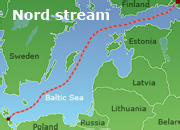Tomorrow, Friday 9 April 2010, in Portovaya Bay on the Russian Baltic Sea coast near St. Petersburg, the Russian President Dmitry Medvedev, together with Alexey Miller, chairman of the Board of Directors of OAO Gazprom, Dr. Hans-Ulrich Engel (member of the Board of Executive Directors of BASF SE) and Dr. Rainer Seele, chairman of Wintershall’s Board of Executive Directors, will officially launch construction work on the Baltic Sea pipeline Nord Stream. While the pipe-laying work in the Baltic Sea is now getting underway, work on the downstream natural gas pipeline OPAL (Ostsee-Pipeline-Anbindungs-Leitung, Baltic Sea pipeline link) in Germany is already in full swing.
It is the longest construction site in Germany: While construction work on Nord Stream is now starting on schedule, work on the connecting German pipeline OPAL in the East of Germany is already in full swing. Around 2,500 construction workers in Mecklenburg-Western Pomerania, Brandenburg and Saxony are currently building the 470-kilometer-long OPAL (Ostsee-Pipeline-Anbindungs-Leitung, Baltic Sea pipeline link). This pipeline will connect the Nord Stream natural gas pipeline (which runs through the Baltic Sea) with the European gas pipeline system and will run from where Nord Stream reaches land on the German Baltic Sea coast near Lubmin, all the way to the Czech Republic. “With the Baltic Sea pipeline and OPAL, direct access to the world’s largest natural gas reserves is being established,” explains Dr. Gerhard Konig, Management Spokesman of WINGAS. “This not only secures Germany’s energy supply, but Europe’s energy supply as well.” The 55 billion cubic meters of natural gas that will be transported with the pipeline, can produce as much power as 55 coal-fired power plants or 20 modern nuclear power plants.
“Commissioning of OPAL is planned for fall 2011, in parallel to the completion of Nord Stream,” continues the WINGAS managing director. “With a capacity of 36 billion cubic meters, OPAL is one of the largest pipelines ever laid in Europe. As a comparison, the capacity corresponds to about a third of Germany’s annual natural gas consumption.” In order to complete OPAL on schedule, several sections are being constructed simultaneously. “Since the beginning of construction work in September, the topsoil has been removed from over 260 kilometers of the pipeline route, around 100 kilometers of piping have been welded and more than 50 kilometers of pipeline sections have already been laid,” reports Michael Muth, WINGAS site manager, on the progress of the pipe-laying work. He adds that staff of construction companies are currently clearing and preparing the site of the intended compressor station near Baruth, south of Berlin.
The OPAL runs southward from Lubmin, passes Berlin in the east, and crosses the German-Czech border in the Erz Mountains. Over its full length, the OPAL pipeline overcomes a height difference of 700 meters and crosses the River Peene in Mecklenburg-Western Pomerania, the River Elbe in Saxony, the A12 highway east of Berlin and the A4 highway between Chemnitz and Dresden, among other feats. The 470-kilometer-long pipeline comprises many individual pipes, each of which is 18 meters long and weighs 15 tonnes. WINGAS is constructing OPAL together with E.ON Ruhrgas AG, which holds a 20-percent stake in OPAL. Network operation of the connecting pipelines will be realized by OPAL NEL TRANSPORT GmbH. This company is part of the WINGAS Group.
In addition to OPAL, another connection pipeline is planned for the Baltic Sea pipeline, in order to transport natural gas from Nord Stream: The NEL (Norddeutsche Erdgasleitung, North German natural gas pipeline) is to run from the Baltic Sea coast near Lubmin, past Schwerin and Hamburg, to the Rehden natural gas storage facility in Lower Saxony. The NEL is designed for a capacity of 20 billion cubic meters. “Both pipelines will further increase Germany’s significance as a natural gas hub for Europe,” points out Gerhard Konig. It is planned that over two billion euros in total are to be invested in expansion of the German pipeline infrastructure in the course of the continuation of Nord Stream.
European energy provider WINGAS GmbH & Co. KG is active in natural gas trading and distribution in Germany, Belgium, France, Great Britain, Austria, the Czech Republic and Denmark. Its customers include municipal utilities, regional gas suppliers, industrial firms and power plants. Since 1990 WINGAS has invested more than 3 billion Euros in the development of a natural gas transport and storage infrastructure. WINGAS TRANSPORT pipeline network, which is over 2,000 kilometers long, connects the major gas reserves in Siberia and in the North Sea to the growing markets in Western Europe. In Rehden in North Germany, WINGAS has the largest natural gas storage facility in Western Europe – with a working gas volume of over four billion cubic meters, and the company also participates in Central Europe's second largest storage facility in Haidach, Austria. Additional natural gas storage facilities are currently being built in Great Britain and Germany in order to secure the supply of natural gas in Europe.
14 Декабря 2025 | воскресенье | 18:35


